
Protea tenax also known as the tenacious sugarbush , is a flowering plant of the family Proteaceae endemic to the Cape Provinces of South Africa and distributed in the Outeniqua, Tsitsikamma, Kouga and Winterhoek mountains as well as the Baviaanskloof. In Afrikaans it is known as Gehardesuikerbos.

Protea rubropilosa, also known as the Transvaal sugarbush, escarpment sugarbush or Transvaal mountain sugarbush, is a flowering tree, that belongs to the genus Protea in the family Proteaceae. The plant only occurs in South Africa.

Protea stokoei is a flowering shrub which belongs to the genus Protea. The plant is endemic to South Africa. It is found in the Kogelberg and Greenland mountains around Elgin.
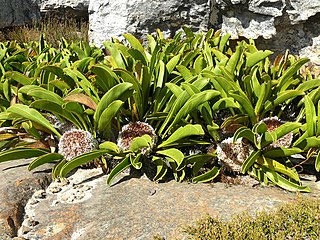
Protea cryophila, the snowball sugarbush, snow protea, or snowball protea, is a flowering shrub of the genus Protea. The plant is endemic to the Cederberg.

Protea lacticolor or the Hottentot sugarbush, Hottentot white sugarbush or Hottentot's Holland sugarbush, is a flowering shrub of the Protea genus. It is also known as the Hottentotwitsukkerbos. The plant is endemic to South Africa and is found from the Slanghoek to the Hottentots Holland Mountains and also the Groenlandberg.
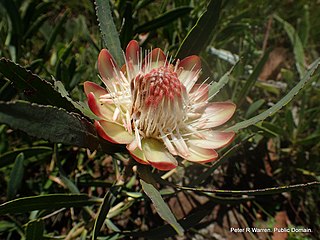
Protea simplex, the dwarf grassveld sugarbush, is a flower-bearing shrub belonging to the genus Protea. It is native to South Africa.
Protea nubigena, commonly known as cloud sugarbush, is a very rare species of a flowering shrub belonging to the Protea genus. It is endemic to KwaZulu-Natal, South Africa and is found in the uKhahlamba Basalt Grassland within the Royal Natal National Park, near Mont-Aux-Sources, at an altitude of about 2,250 metres (7,380 ft) in well-drained, humus-rich soil on shaded slopes.

Protea subulifolia, the awl-leaf sugarbush, is a flower-bearing shrub belonging to the Protea genus. The plant is native to the Western Cape and occurs from the Stettynskloof to Riviersonderendberge, Langeberg, Bot River to the Elim plain. The plant grows 50 cm in diameter and 70 cm tall and flowers from July to September.
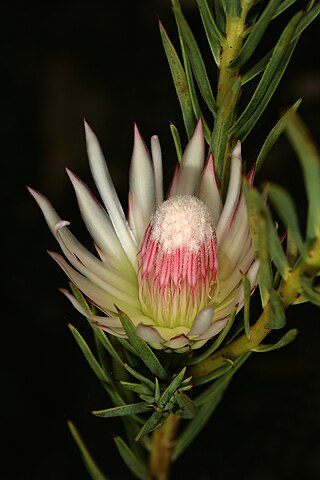
Protea mucronifolia, the dagger-leaf sugarbush, is a flower-bearing shrub belonging to the Protea genus. The plant is endemic to the Western Cape where it occurs from Hermon to Saron. This is the only population. The shrub grows upright and grows 1 m tall and flowers from October to January with the peak from November to December.

Protea humiflora, the patentleaf sugarbush, is a flower-bearing shrub belonging to the Protea genus. The plant is endemic to South Africa and occurs from the Du Toitskloof Mountains to the Langeberg and Waboomsberg. The plant grows to 2 m in diameter and flowers from July to September with its peak in August.
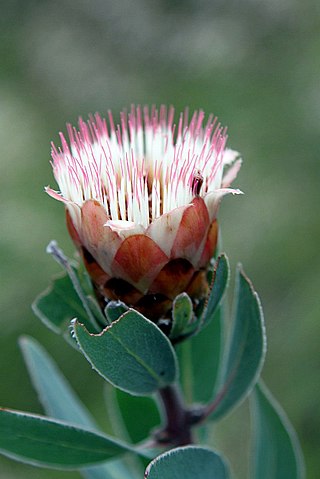
Protea subvestita, the waterlily sugarbush, is a flower bearing shrub that belongs to the well-known genus Protea. The plant is endemic to South Africa and occurs in Mpumalanga on the escarpment of the Wakkerstroom, Free State, KwaZulu-Natal, Lesotho, Eastern Cape and the Klein Swartberg. The shrub is large, erect and grows up to 5 m. It flowers mainly from January to March.

Protea venusta, the cascade sugarbush or creeping beauty, is a flower-bearing shrub belonging to the genus Protea. It is endemic to South Africa.
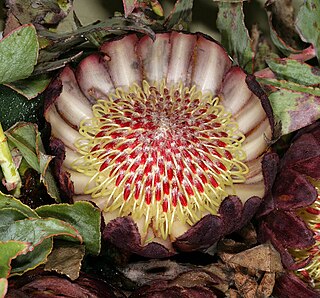
Protea amplexicaulis, the clasping-leaf sugarbush, is a flower-bearing shrub that belongs to the genus Protea. The plant is endemic to South Africa and occurs from Citrusdal to the Kogelberg, as well as in the Langeberg. The shrub remains low and spreads out, becoming 1.3 m in diameter and flowering from June to September.
Leucadendron cryptocephalum, the concealed conebush, is a flower-bearing shrub that belongs to the genus Leucadendron and forms part of the fynbos. The plant is native to the Western Cape and only two populations occur at Potberg and the Groenlandberg. There is little information available about the plant.
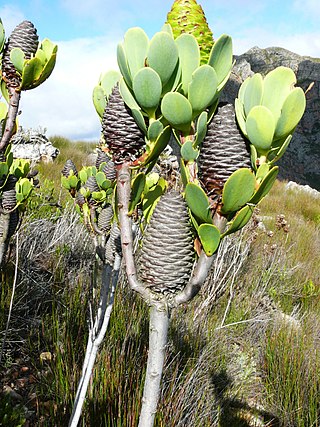
Leucadendron immoderatum, the lollipop conebush, is a flower-bearing shrub belonging to the genus Leucadendron and forms part of the fynbos. The plant is native to the Western Cape where it occurs at Riviersonderend.

Spatalla longifolia, the pink-stalked spoon, is a flower-bearing shrub that belongs to the genus Spatalla. It forms a part of the fynbos. The plant is native to the Western Cape of South Africa where it is found in the Hottentots-Holland Mountains; from Franschhoek and Villiersdorp to the Kleinmond Mountains.
Spatalla tulbaghensis, the shaggy-hair spoon, is a flowering shrub belonging to the genus Spatalla and forms part of the fynbos. The plant is native to the Western Cape where it occurs on the Witzenberg Plains and Skurweberg Pass.
Spatalla nubicola, the Medusa spoon, is a flower-bearing shrub that belongs to the genus Spatalla and forms part of the fynbos. The plant is native to the Western Cape of South Africa where it is found in the central Langeberg near the town of Heidelberg.

Spatalla racemosa, the lax-stalked spoon, is a flower-bearing shrub that belongs to the genus Spatalla and forms part of the fynbos. The plant is native to the Western Cape of South Africa where it is found in the Kogelberg, Groenland mountains, Babilonstoringberge, Kleinrivier Mountains as well as at Villiersdorp.
Sorocephalus teretifolius, the pinhead clusterhead, is a flowering shrub that belongs to the genus Sorocephalus and forms part of the fynbos. The plant is endemic to the Western Cape where it occurs in the Palmiet River valley in the Kogelberg.
















